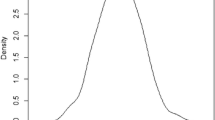Abstract
We consider the parametric estimation with right-censored competing risks data and with masked failure cause. We propose a new model, called the random partition masking (RPM) model. The existing model based on the so called symmetry assumption, but the RPM model does not need the symmetry assumption. We propose a wide class of parametric distribution families of the failure time and cause, which does not need the assumption of independence between the components of the system. We also study the asymptotic properties of the maximum likelihood estimator under the new model, and apply our procedure to a medical and an industrial data sets.
Similar content being viewed by others
References
Craiu R.V., Duchesne T. (2004) Inference based on the EM algorithm for the competing risks model with masked causes of failure. Biometrika, 91: 543–558
Craiu R.V., Reiser B. (2006) Inference for the dependent competing risks model with masked causes of failure. Lifetime Data Analysis, 12: 21–33
Dinse G.E. (1982) Nonparametric estimation for partially-complete time and type of failure data. Biometrics, 38: 417–431
Dinse G.E. (1986) Nonparametric prevalence and mortality estimators of animal experiments with incomplete cause-of-death data. JASA, 81: 328–336
Ferguson T.S. (1996) A course in large sample theory. Chapman & Hall, New York
Flehinger B.J., Reiser B., Yashchin E. (1996) Inference about defects in the presence of masking. Technometrics, 38: 247–255
Flehinger, B. J., Reiser, B., Yashchin, E. (2001). Statistical analysis for masked data. In N. Balakrishnan, C. R. Rao (Eds.), Handbook of statistics (Vol. 20, pp. 499–522). Amsterdam: Elsevier.
Friedman L., Gertsbakh I.B. (1980) Maximum likelihood estimation in a minimum type model with exponential and Weibull failure modes. JASA, 75: 460–465
Guttman I., Lin D.K.J., Reiser B., Usher J.S. (1995) Dependent masking and system life data analysis: Bayesian inference for two-component systems. Lifetime Data Analysis, 1: 87–100
Kalbfleisch J.D., Prentice R.I. (2002) The statistical analysis of failure time data (2nd ed). Wiley, Hoboken
Kuo L., Yang T.Y. (2000) Bayesian reliability modeling for masked system lifetime data. Statistics & Probability Letters, 47: 229–241
Lawless J.F. (2003) Statistical models and methods for lifetime data (2nd ed). Wiley, New York
Lin D.K.J., Guess F.M. (1994) System life data analysis with dependent partial knowledge on the exact cause of system failure. Microelectronics and Reliability, 34: 535–544
Mukhopadhyay C. (2006) Maximum likelihood analysis of masked series system lifetime data. Journal of Statistical Planning and Inference, 136: 803–838
Mukhopadhyay C., Basu S. (2007) Bayesian analysis of masked series system lifetime data. Communications in Statistics-Theory and Methods, 36: 329–348
Nagai, Y. (2004). Maximum likelihood analysis of masked data in competing risk models with an environmental stress. IEICE Transactions on Fundamentals of Electronics, Communications and Computer Sciences, E87-A(12), 3389–3396.
Reiser B., Guttman I., Lin D.K.J., Usher J.S., Guess F.M. (1995) Bayesian inference for masked system lifetime data. Journal of the Royal Statistical Society, Ser C Applied Statistics, 44: 79–90
Sen, A., Basu, S., Benerjee, M. (2001). Analysis of masked failure time data under competing risks. In N. Balakrishnan, C. R. Rao (Eds.), Handbook of statistics (Vol. 20, pp. 523–540). Amsterdam: Elsevier.
Turnbull B.W. (1976) The empirical distribution function with arbitrary grouped, censored and truncated data. Journal of Royal Statistics Society, Ser. B, 38: 290–295
Yu, Q. Q., Wong, G. Y. C., Qin, H., Wang, J. (2009). Technical report for “Random partition masking model for censored and masked competing risks data.” http://math.binghamton.edu/qyu.
Author information
Authors and Affiliations
Corresponding author
About this article
Cite this article
Yu, Q., Wong, G.Y.C., Qin, H. et al. Random partition masking model for censored and masked competing risks data. Ann Inst Stat Math 64, 69–85 (2012). https://doi.org/10.1007/s10463-010-0303-8
Received:
Revised:
Published:
Issue Date:
DOI: https://doi.org/10.1007/s10463-010-0303-8




